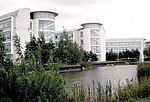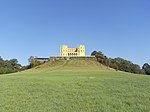Bristol Robotics Laboratory

The Bristol Robotics Laboratory (BRL), established in 2004, is the largest academic centre for multi-disciplinary robotics research in the UK. It is the result of a collaboration between the University of Bristol and the University of the West of England in Bristol and is situated on UWE's Frenchay Campus. An internationally recognised Centre of Excellence in Robotics, the Bristol Robotics Laboratory covers an area of over 4,600 sq. metres (50,000 sq. feet). The Laboratory is currently involved in interdisciplinary research projects addressing key areas of robot capabilities and applications including human-robot interaction, unmanned aerial vehicles, driverless cars, swarming behaviour, non-linear control, machine vision, robot ethics and soft robotics. The BRL co-directors are Professors Manual Giuliani and Arthur Richards.
Excerpt from the Wikipedia article Bristol Robotics Laboratory (License: CC BY-SA 3.0, Authors, Images).Bristol Robotics Laboratory
Coldharbour Lane, Bristol
Geographical coordinates (GPS) Address Website Nearby Places Show on map
Geographical coordinates (GPS)
| Latitude | Longitude |
|---|---|
| N 51.501 ° | E -2.552 ° |
Address
University of the West of England, Frenchay Campus (UWE Bristol)
Coldharbour Lane Frenchay Campus
BS16 1QY Bristol
England, United Kingdom
Open on Google Maps







